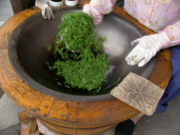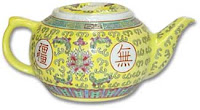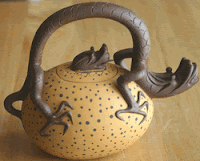The secret of green tea was passed to me by a yogi, high on a mountain top, in a ceremony where I endured great pain in order to bring you this information, such is my dedication to you, my reader......ok, ok...I looked it up in a journal and talked to a tea-ologist. You people are just no fun.
Anyway, the secret lies in the fact it is rich in catechin polyphenols, particularly epigallocatechin gallate (EGCG). Now say that 5 times fast. I tried...it was ugly. EGCG, (much easier to say,) is a powerful anti-oxidant: 1. Besides inhibiting the growth of cancer cells, it: 2. kills cancer cells without harming healthy tissue. It has also been effective in lowering LDL cholesterol levels and inhibiting the abnormal formation of blood clots. The latter, takes on added importance when you consider that thrombosis (the formation of abnormal blood clots) is the leading cause of heart attacks and stroke. Green tea can even help prevent tooth decay! Just as its bacteria-destroying abilities can help prevent food poisoning, it can also kill the bacteria that causes dental plaque. Meanwhile, skin preparations containing green tea, from deodorants to creams, are starting to appear on the market.
New evidence is emerging that green tea can even help dieters. The American Journal of Clinical Nutrition published the results of a study at the University of Geneva in Switzerland where men who were given a combination of caffeine and green tea extract burned more calories than those given only caffeine or a placebo. Wow, almost sounds like those snake oil sales pitches from the old west, you know, "You can wash the dog with it AND, it's great in salads." There are a number of varieties of green tea, both Chinese and Japanese and well cover them all, but the first and coolest thing I wanted to share with you is, Flowering or Performance Teas. My personal preference is TeaPosy, but there are many on the market from which to choose.
Flowering teas, also known as blooming teas, performance teas, and display teas, among other names, are hand-sewn individual tea leaves forming a ball, and designed to perform an action when steeped in hot water, usually unfurling into decorative flower-like arrangements. Flowering teas are usually prepared in glass or otherwise transparent cups or mugs so that the performance can be seen. Flowering tea primarily uses green, white and jasmine tea. This video is so cool!
Chinese Green Teas
 The Chinese have known about the medicinal benefits of green tea since ancient times, using it to treat everything from headaches to depression. Today, scientific research in both Asia and the west is providing hard evidence for the health benefits long associated with drinking green tea.
The Chinese have known about the medicinal benefits of green tea since ancient times, using it to treat everything from headaches to depression. Today, scientific research in both Asia and the west is providing hard evidence for the health benefits long associated with drinking green tea.- Longjing- The most famous of green teas, originates from China, in the region known as Hangzhou, specifically the Zhejiang province, where it is produced mostly by hand and is renown for it's high quality. It is divided into 7 grades : Superior, Special, and the grades 1 down to 5.It's name in Chinese means dragon well. It is pan-fried and has a distinctive flat appearance. Falsification of Longjing is very common, and most of the tea on the market is in fact produced in Sichuan Province and hence not authentic Longjing.
- Hui Ming-Named after a temple in Zhejiang.
- Long Ding-A tea from Kaihua County known as Dragon Mountain.
- Hua Ding-A tea from Tiantai County and named after a peak in the Tiantai mountain range.
- Qing Ding-A tea from Tian Mu, also known as Green Top.
- Gunpowder-A popular tea also known as zhuchá. It originated in Zhejiang but is now grown elsewhere in China.
Japanese Green Teas
- Gyokuro (Jade Dew) -The highest grade Japanese green tea cultivated in special way. Gyokuro's name refers to the pale green color of the infusion. The leaves are grown in the shade before harvest, which alters their flavor. Gyokuro has a high caffeine content , but the significant L-Theanine content of Gyokuro slows down and counteracts the caffeine assimilation, and also the amount ingested is very small.
- Matcha (rubbed tea)-A fine ground Ten-cha ( has very similar cultivation process as Gyokuro) used primarily in the tea ceremony. Matcha is also a popular flavor of ice cream and other sweets in Japan.
- Sencha (broiled tea)-The first and second flush of green tea, which is the most common green tea in Japan made from leaves that are exposed directly to sunlight.
- Genmaicha (Brown-Rice tea)- Bancha (sometimes Sencha) and roasted genmai (brown rice) blend. It is often mixed with small amount of Matcha to make the colour better.
- Kabusecha (covered tea)- Kabusecha is sencha tea, the leaves of which have grown in the shade prior to harvest, although not for as long as Gyokuro. It has a more delicate flavor than Sencha.
- Bancha (common tea)-Sencha harvested as a third or fourth flush tea between summer and autumn.
- Aki-Bancha (autumn Bancha)- is not made from entire leaves, but from the trimmed unnecessary twigs of the tea plant.
- Houjicha (pan fried tea)- A strong roasted green tea.
- Kukicha (stalk tea)- A tea made from stalks produced by harvesting one bud and three leaves.
- Tamaryokucha- A tea that has a tangy, berry-like taste, with a long almondy aftertaste and a deep aroma with tones of citrus, grass, and berries.
Tea's Origins
There is archaeological evidence that suggests that tea has been consumed for almost 5000 years, with China and India being two of the first countries to cultivate it. Green tea has been used as traditional medicine in areas such as India, China, Japan and Thailand.
Legends about the origins of tea have been passed on from generation to generation. One such story, dating back to 2700 BCE, describes how tea leaves, blown by the wind, accidentally fell into a Chinese Herbalist's pot of hot water. The water now tasted of these wild leaves, and the herbalist, Shen Nung, found its soothing taste and fine flavors so irresistible that he instructed all of his people to drink in the wonders of the beverage.
 Another story explains how the Indian Monk, Bodhidharma, sailed to China and went into a nine-year meditation. During this "Zen experience," he began to dose off and closed his eyes for a moment. He instantly cut off his eyelids to avoid sleeping, and where they fell to the ground a tea bush sprouted from the earth. The plant found then another home with Buddhists in their meditation, helping them to stay awake and to maintain a high level of alertness and concentration
Another story explains how the Indian Monk, Bodhidharma, sailed to China and went into a nine-year meditation. During this "Zen experience," he began to dose off and closed his eyes for a moment. He instantly cut off his eyelids to avoid sleeping, and where they fell to the ground a tea bush sprouted from the earth. The plant found then another home with Buddhists in their meditation, helping them to stay awake and to maintain a high level of alertness and concentrationThere are many other stories about the origins of tea and how it found its way into our cup of boiling water. But the wonderful fact is we did not discover tea, "tu", "cha" or "tay", it discovered us through our openness and willingness to take in its beautiful offerings. Whether it was a Buddhist monk, an Emperor or a cultivator of the times, tea was, and still is, used to nurture the body and uplift the soul. The subtle flavors and health benefits of this magnificent plant make it the world's most popular beverage after water.
Brewing
Green tea brewing time and temperature varies with individual teas. The hottest brewing temperatures are 180°F to 190°F (82°C to 88°C) and the longest steeping times 2 to 3 minutes. The coolest brewing temperatures are 140°F to 150°F (60°C to 66°C) and the shortest steeping times about 30 seconds. In general, lower quality green teas are steeped hotter and longer, while higher quality teas are steeped cooler and shorter. Steeping green tea too hot or too long will result in a bitter, astringent brew. High quality green teas can and usually are steeped multiple times; 2 or 3 steepings is typical.
Generally, 2.25 grams of tea per 6 ounces of water, or about one teaspoon of green tea per cup, should be used. With very high quality teas like gyokuro, more than this amount of leaf is used, and the leaf is steeped multiple times for short durations.
Gaiwan Tea Preparation
 drinking had always been some form of bowl, “gaiwan” was adopted.
drinking had always been some form of bowl, “gaiwan” was adopted.As its name suggests, the significant feature of a gaiwan is its lid, which is not merely a cover, but is designed to fit snuggly inside the lip of the cup. When the form of tea changed from whisked in a bowl to infused (as tea is prepared today), a way was sought to simplify the tea making process. The small porcelain cup used for drinking this type of tea was modified and fitted with a special cover which allowed the leaves to be infused right in the cup and the tea either drunk directly from there or decanted into smaller tasting cups and served to guests. The addition of a third element, the accompanying plate or saucer, completes the set, ingeniously insulating the bottom of the cup so that it may be handled when hot.
 1. RINSE- Whatever the type of tea being brewed, the first step is always to rinse cup with hot water. This performs two functions: first, it purifies the cup (both practically and symbolically) by rinsing away any dust or residue and symbolizing that the cup is clean, empty and ready to receive the tea. Secondly, rinsing with hot water warms the cup, which, at room temperature, is quite cold and therefore inappropriate for brewing most fine teas whose temperature must be carefully controlled. The water should be poured from the gaiwan into the serving pitcher and from there into the tasting cups to warm them and then discarded.
1. RINSE- Whatever the type of tea being brewed, the first step is always to rinse cup with hot water. This performs two functions: first, it purifies the cup (both practically and symbolically) by rinsing away any dust or residue and symbolizing that the cup is clean, empty and ready to receive the tea. Secondly, rinsing with hot water warms the cup, which, at room temperature, is quite cold and therefore inappropriate for brewing most fine teas whose temperature must be carefully controlled. The water should be poured from the gaiwan into the serving pitcher and from there into the tasting cups to warm them and then discarded.2. TEA LEAVES- The tea leaves should be prepared in advance and ready to be placed in the gaiwan as soon as it has been warmed. (A tea caddy or “tea presentation vessel”, as shown, is recommended for this purpose, as is a proper set of tea tools. Approximately one to two teaspoons of leaf is a good quantity to begin with and is easily adjusted to taste after the initial infusion. Keep in mind that due to the many variations of tea processing, some leaves are a lot more compact than others. For instance: you’ll need a lot less Dragon Well or Jasmine Pearls than Silver Needles or Formosa Oolong.
3. AROMA- Before infusion a few drops of water from the kettle should be added to the leaves. This releases the tea’s aroma and should be savored prior to infusion in order to prepare the palate to appreciate the full flavor of the tea and also suggests to the experienced tea maker how to approach the infusion. Alternatively, some people like to cover the leaves with hot water and quickly pour it off. This is known as “flushing” the tea and is recommended particularly for tightly rolled and aged teas, such as oolong
 and Puerh. As above, the wet leaves’ aroma should be appreciated before brewing.
and Puerh. As above, the wet leaves’ aroma should be appreciated before brewing.4. WATER- 99% of tea is water, so it’s important to give some thought to the water you use for brewing. Tap water should be avoided since its chemical treatment imparts undesirable flavors and odors which interfere with the delicate aromatics of tea. Home filters and other water purification systems can minimize and, in some cases, eliminate these problems. The best water for tea brewing is spring water with a natural mineral content that’s neither too hard nor too soft. Since T.D.S. “total dissolved solids”, or mineral content measured in parts per million varies greatly from water to water, you may want to do your own taste-test of waters available in your area to determine which one has the best flavor, body and compatibility with the tea you drink.
Accessories
 Is there anything quite as humble yet so essential as the teapot? One of man-kind's great inventions to be sure. Whether made of clay, metal or glass, be they plain or elaborate in design, traditional or contemporary in style, and from whatever country, they all serve one purpose, to produce a beverage that is comforting, calming, and of course, delicious.There are many different styles to choose from so
Is there anything quite as humble yet so essential as the teapot? One of man-kind's great inventions to be sure. Whether made of clay, metal or glass, be they plain or elaborate in design, traditional or contemporary in style, and from whatever country, they all serve one purpose, to produce a beverage that is comforting, calming, and of course, delicious.There are many different styles to choose from so  picking one that fits your taste should be easy. There are many online companies that have teapots and tea sets available, or you can seek out an Asian Specialty store in your area to find whats right for you.
picking one that fits your taste should be easy. There are many online companies that have teapots and tea sets available, or you can seek out an Asian Specialty store in your area to find whats right for you.Whatever your preference, open your mind and your body to 'Good Living' and discover the joys and benefits of Green Tea.
Bon Appetit,







No comments:
Post a Comment